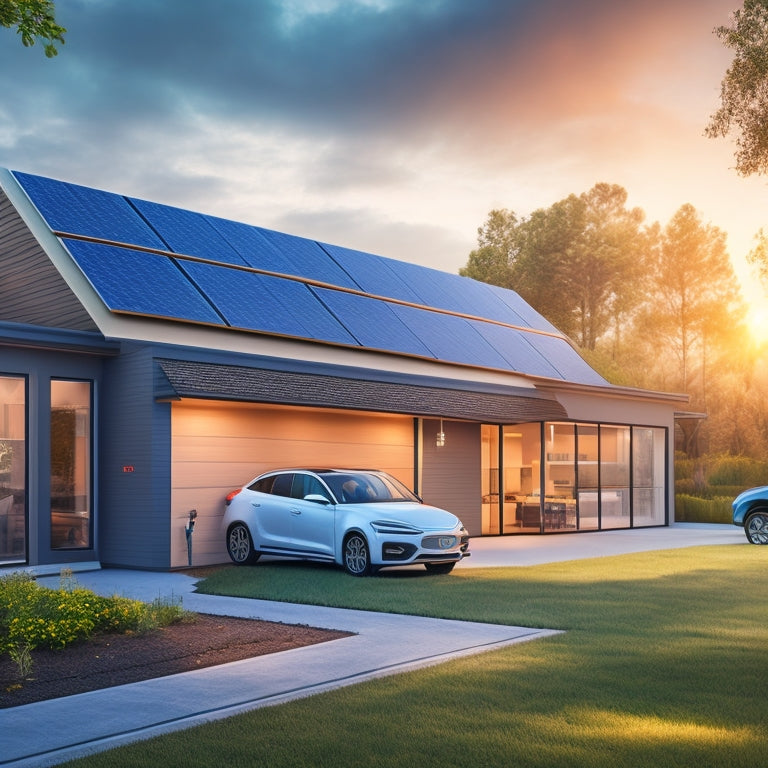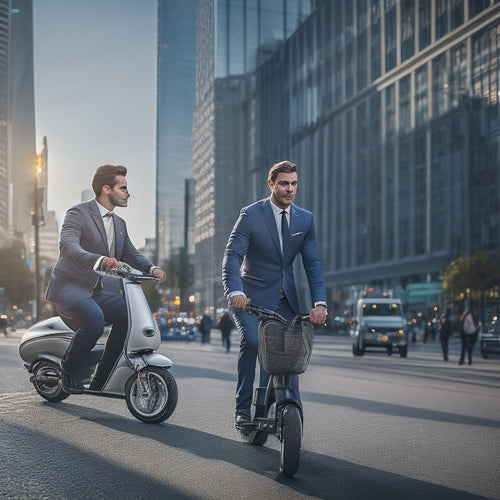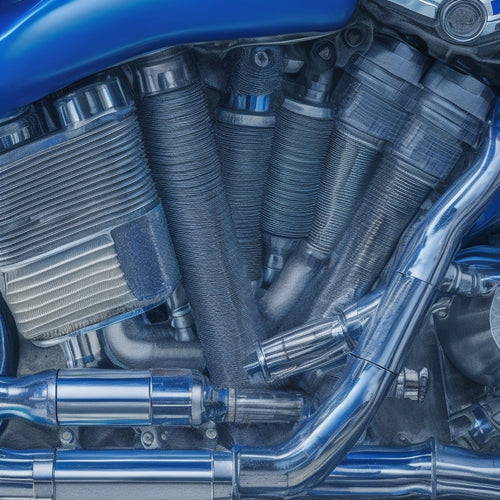
10 Ways EVs Can Power Your Home
Share
You can access a multitude of benefits by harnessing the power of your electric vehicle (EV) to energize your home. For instance, your EV can provide backup power during outages, sell excess energy back to the grid, and even manage peak hour energy consumption to reduce your bills. You can also utilize your EV's battery as energy storage, use it as an energy hub, or even transfer energy to devices and appliances. By exploring these possibilities, you'll discover the full potential of your EV to power your home, and that's just the beginning of your journey to energy autonomy.
Key Takeaways
• Electric vehicles can provide backup power during outages, supplying several days of electricity and powering essential appliances.
• EVs can act as an emergency power source, keeping your home comfortable and safe during severe weather or disasters.
• By charging your EV during off-peak hours and using stored energy to power your home, you can reduce energy costs and increase energy independence.
• EVs can be used as a portable power source, charging devices like laptops and smartphones using the vehicle's battery power.
• Integrating EVs with smart home energy management systems can help monitor and manage energy consumption, reducing carbon footprint and saving on energy costs.
Vehicle-to-Home Power Backup
With Vehicle-to-Home (V2H) technology, your electric vehicle can provide backup power to your home during outages, supplying up to several days of electricity depending on the capacity of your vehicle's battery and your home's energy needs.
This innovative solution guarantees that you're always connected, even when the grid isn't. Imagine having the peace of mind that your fridge stays running, your lights stay on, and your family stays safe during an outage. Your electric vehicle effectively becomes a generator, powering your home's essential systems.
As an added benefit, some Vehicle Insurance providers offer special discounts for EV owners who invest in V2H technology, recognizing the reduced risk of accidents and theft. Additionally, integrating your EV with Home Automation systems enables seamless control over your home's energy distribution, optimizing energy efficiency and reducing waste.
Reducing Peak Hour Energy Consumption
By intelligently managing your EV's charging schedule, you can reduce your home's peak hour energy consumption, alleviating strain on the grid and potentially lowering your electricity bills.
One effective strategy is to take advantage of Time of Use (TOU) pricing, a type of energy tariff that varies electricity rates based on the time of day. By charging your EV during off-peak hours, such as overnight, you can capitalize on lower rates and reduce your energy costs.
Additionally, you can program your EV's charging schedule to coincide with periods of low energy demand, further reducing peak hour consumption. This not only benefits your wallet but also helps to mitigate the strain on the grid during peak hours.
Selling Energy Back to Grid
As you explore selling energy back to the grid, you'll want to understand the role of grid tie systems in enabling this process.
These systems allow your EV's battery to feed excess energy back into the grid, and they're a critical component of net metering arrangements.
Grid Tie Systems
You can utilize the excess energy generated by your EV's charging system through a grid tie system, which enables you to sell the surplus back to the grid. This system allows you to take advantage of your EV's energy storage capacity, feeding excess energy back into the grid when you're not using it.
By doing so, you can offset your energy costs and even generate revenue. To make this achievable, you'll need to make sure your energy infrastructure is equipped with the necessary technology to facilitate a grid tie system. This typically involves installing an inverter that synchronizes your EV's energy output with the grid's frequency and voltage.
With a grid tie system, you can maximize your EV's energy potential, reducing your reliance on the grid and increasing your energy independence. Additionally, by feeding energy back into the grid, you're helping to increase grid capacity, supporting the overall stability of the energy infrastructure.
Net Metering Benefits
When you sell excess energy back to the grid through a grid tie system, net metering benefits come into play, allowing you to offset your energy costs and even generate revenue. As you produce more energy than you consume, you can feed the excess back into the grid and receive energy credits. These credits can be used to offset your energy consumption during periods of low energy production, effectively reducing your energy bills.
The benefits of net metering include:
-
Reduced energy costs: By selling excess energy back to the grid, you can offset your energy costs and reduce your bills.
-
Metering incentives: You can earn revenue by selling excess energy back to the grid, providing a new stream of income.
-
Increased energy independence: With net metering, you have more control over your energy production and consumption, allowing you to be more energy-independent.
- Environmental benefits: By producing and consuming renewable energy, you're reducing your carbon footprint and contributing to a cleaner environment.
Emergency Power During Outages
During prolonged grid outages, your electric vehicle can function as a backup power source, providing emergency electricity to your home. This is especially vital during severe weather events or natural disasters, where storm protection is paramount. With outage planning, you can rely on your EV to keep your essential appliances running.
Here's a breakdown of how your EV can power your home during an outage:
| Appliance | Power Required | EV Capacity |
|---|---|---|
| Refrigerator | 1.5 kW | 10 hours |
| Medical Equipment | 0.5 kW | 20 hours |
| Lighting | 0.2 kW | 40 hours |
| Laptop | 0.1 kW | 80 hours |
In the event of an outage, your EV can provide a reliable source of power, ensuring your home remains comfortable and safe. By understanding your energy needs and EV's capacity, you can plan accordingly and stay prepared for the unexpected.
EV Battery as Energy Storage
As you explore the possibilities of using your EV as a power source, you'll want to contemplate how its battery can function as energy storage.
You can charge your EV at home, and then use that stored energy to power your home when needed.
Charging at Home
You can harness the energy storage potential of your electric vehicle's (EV's) battery to power your home by charging it strategically during off-peak hours. This approach not only reduces your energy bills but also enhances your home decor with a touch of sustainability.
Imagine waking up to a fully charged EV, ready to power your home appliances, and enjoying the personal convenience of having a backup energy source.
Here are some benefits of charging your EV at home:
-
Cost-effective: Charging your EV during off-peak hours can greatly reduce your energy bills, making it a cost-effective solution for homeowners.
-
Increased energy independence: By harnessing the energy storage potential of your EV's battery, you can reduce your reliance on the grid and enjoy increased energy independence.
-
Enhanced home decor: A sustainable and eco-friendly energy solution can elevate your home decor, making it a great conversation starter for your guests.
- Personal convenience: With an EV battery as an energy storage solution, you can enjoy the personal convenience of having a backup energy source, ensuring your home remains powered even during outages.
Energy Backup
By leveraging your EV's battery as an energy storage solution, you can guarantee a reliable backup power source for your home during outages or emergencies. This is especially important for households with critical medical equipment or those living in areas prone to natural disasters. By tapping into your EV's battery, you can secure energy independence and reduce your reliance on the grid.
Here's a breakdown of how EVs can provide backup power:
| Feature | Benefit | Example |
|---|---|---|
| Grid Outage Protection | Automatically switches to EV power during outages | Keep your fridge running and lights on during a blackout |
| Renewable Energy Integration | Store excess energy generated by solar or wind power | Maximize your renewable energy investment |
| Load Management | Prioritize energy allocation to critical appliances | Ensure your medical equipment stays powered |
| Energy Monitoring | Track and optimize your energy usage | Identify areas for energy efficiency improvement |
With the ability to store excess energy and provide backup power, your EV can become an essential component of your home's energy management system. By integrating your EV's battery into your home's energy infrastructure, you can take a significant step towards energy independence and peace of mind.
Home Energy Efficiency Optimization
Maximizing your home's energy efficiency is crucial to fully reap the benefits of using your EV as a power source. By optimizing your home's energy usage, you can guarantee that the energy generated by your EV is utilized efficiently and effectively. This not only reduces your reliance on the grid but also minimizes energy waste.
To achieve peak energy efficiency, consider the following:
-
Conduct an energy audit: Identify areas of energy inefficiency in your home and prioritize improvements.
-
Upgrade to smart insulation: Reduce heat loss and gain by installing advanced insulation materials.
-
Seal air leaks: Caulk and weatherstrip to prevent heated or cooled air from escaping.
- Install energy-efficient appliances: Replace old appliances with Energy Star-rated ones to decrease energy consumption.
Electric Vehicle as Energy Hub
With your home's energy efficiency optimized, your electric vehicle can now serve as a central energy hub, feeding excess energy back into your home's electrical system. This setup enables you to achieve a higher level of energy autonomy, relying less on the grid and more on your own renewable energy sources.
As you generate excess energy, your EV can store it and redistribute it to power your home, reducing your reliance on non-renewable energy sources. This setup is a key component of future infrastructure, where homes and vehicles work in tandem to create a sustainable energy ecosystem.
Peak Shaving for Lower Bills
Your electric vehicle's energy storage capacity can help you reduce your energy bills by shaving peak demand during periods of high energy usage. This concept, known as peak shaving, is a demand management strategy that optimizes your energy consumption to minimize costs.
By leveraging your EV's energy storage, you can reduce your reliance on the grid during peak hours, resulting in lower bills.
Here are some benefits of peak shaving:
-
Reduced energy costs: By reducing your energy consumption during peak hours, you can take advantage of lower rates and minimize your energy expenditure.
-
Optimized energy usage: Peak shaving allows you to optimize your energy usage, ensuring that you're using the right amount of energy at the right time.
-
Increased energy independence: By relying less on the grid, you're increasing your energy independence and reducing your reliance on external energy sources.
- Improved rate optimization: Peak shaving enables you to optimize your energy rates, ensuring that you're paying the lowest possible rates for your energy consumption.
Vehicle-to-Load Energy Transfer
As you explore Vehicle-to-Load (V2L) energy transfer, you'll discover the ability to charge your devices and power home appliances directly from your EV's battery.
This innovative technology enables you to harness the energy stored in your vehicle to power your daily essentials.
Charging Your Devices
You can utilize your EV's Vehicle-to-Load (V2L) capability to charge your devices, such as laptops, smartphones, and power tools, whenever and wherever you need to. This feature allows you to tap into your EV's battery power to keep your devices running, making it an excellent portable power source.
One of the significant advantages of V2L is its device compatibility. Most modern EVs come equipped with standard outlets or USB ports, making it easy to plug in and charge your devices.
Here are some benefits of using V2L for charging your devices:
-
Convenience: Charge your devices on-the-go, without needing to find a wall outlet.
-
Portability: Take your EV's power with you, wherever you need it.
-
Reliability: Rely on your EV's battery to keep your devices running, even in areas with limited power access.
- Flexibility: Use your EV as a backup power source during outdoor events or in emergency situations.
Powering Home Appliances
With a Vehicle-to-Load energy transfer system, an EV can supply electricity to power home appliances, offering a convenient and efficient way to utilize its battery capacity. You can effectively turn your electric vehicle into a mobile generator, providing power to your home when you need it most.
This technology enables you to allocate energy to specific appliances, allowing you to prioritize which devices to power first. Appliance Prioritization is important in this scenario, as you'll want to make sure critical appliances like refrigerators and medical equipment receive power first.
Energy Allocation is also key, as you'll need to balance the energy output of your EV with the power requirements of your appliances. By doing so, you can efficiently distribute energy to the devices that need it most.
Imagine being able to power your lights, computers, and even medical equipment during an outage, all from the comfort of your own electric vehicle. With Vehicle-to-Load energy transfer, you'll have the flexibility and peace of mind that comes with having a reliable backup power source.
Smart Home Energy Management
Your home's energy usage can be optimized and controlled through smart home energy management systems that integrate with electric vehicles. These systems enable you to monitor and manage your energy consumption in real-time, making it easier to reduce your carbon footprint and save on energy costs.
With smart home energy management, you can automate energy-intensive tasks during off-peak hours when energy rates are lower. This helps in optimizing energy storage by charging your EV's battery during periods of low energy demand.
Monitoring energy usage in real-time allows you to identify areas of inefficiency. You can also control energy distribution to prioritize power-hungry appliances during periods of low energy demand.
Frequently Asked Questions
Can I Use My EV to Power My Home's HVAC System?
You can leverage your EV's energy storage to power your home's HVAC system, providing climate control while reducing your reliance on the grid, but be mindful of your vehicle's battery health and charging schedules.
How Much Does a Vehicle-To-Home Power System Cost?
As you ponder the alchemist's dream of transmuting your EV into a power source, you'll need to factor in system upgrades and installation costs, which can range from $5,000 to $15,000, depending on the complexity of your setup.
Is Vehicle-To-Home Technology Compatible With All EV Models?
You'll find that vehicle-to-home technology isn't compatible with all EV models, as brand limitations and model variations come into play, making it essential to check compatibility before investing in a system.
Can I Charge My EV and Power My Home Simultaneously?
You can charge your EV and power your home simultaneously with dual charging systems, utilizing your vehicle's energy storage capacity to supply your home's electrical needs while replenishing your car's battery.
Do I Need a Special License to Sell Energy Back to the Grid?
You don't need a special license to sell energy back to the grid, but you'll need to comply with grid regulations and enroll in a Net Metering program, which varies by utility company and local policies.
Related Posts
-

Why Choose Affordable Electric Scooters for Urban Commuting
By choosing an affordable electric scooter for urban commuting, you'll not only reduce your transportation costs by u...
-

3 Ways to Increase Motorcycle Horsepower
You're about to unleash your motorcycle's hidden power by exploiting three key areas. First, upgrade your electric mo...
-

7 Best Financial Incentives for Residential Homeowners
You're entitled to a range of financial incentives that can help offset the costs of owning a home, from federal tax ...


